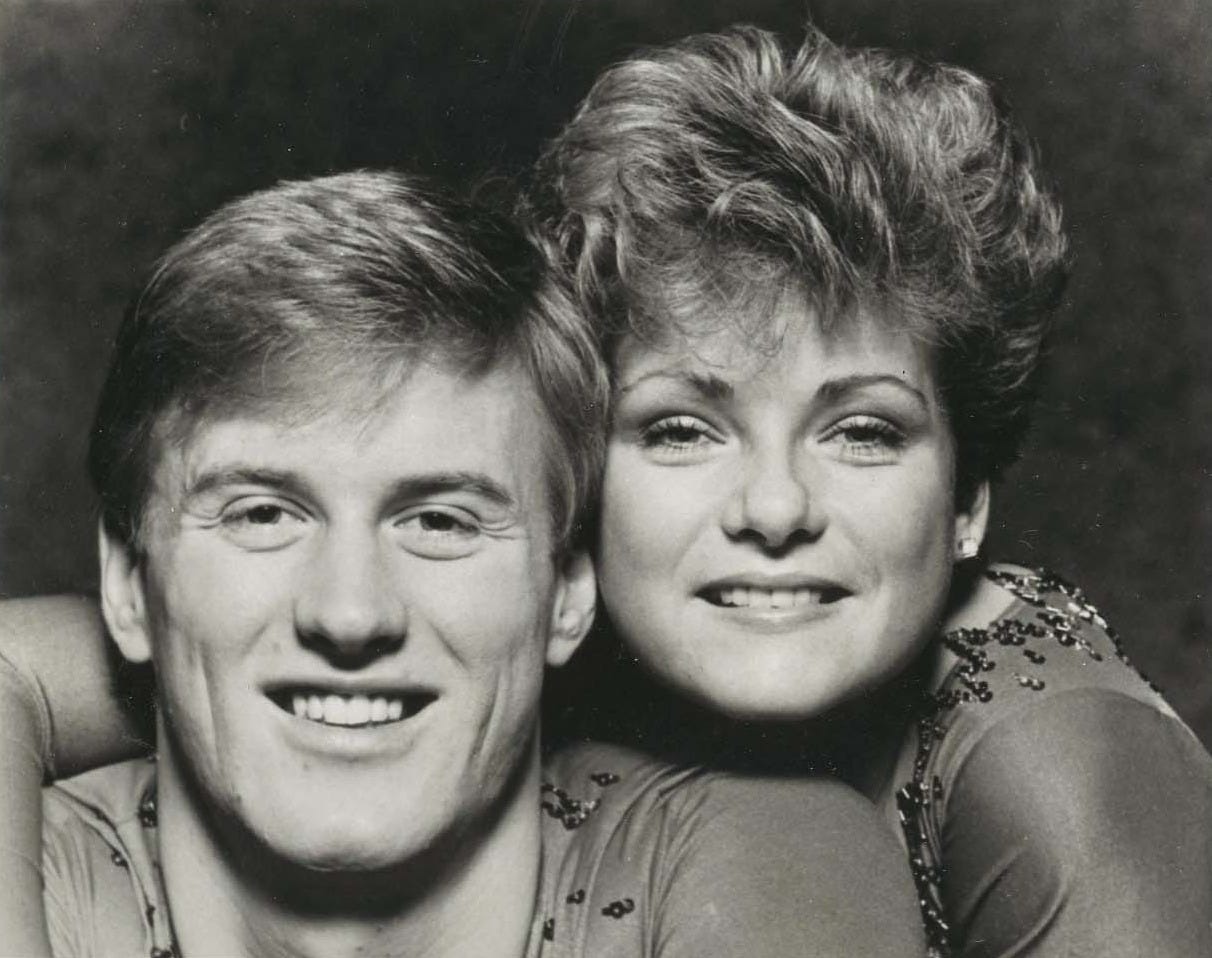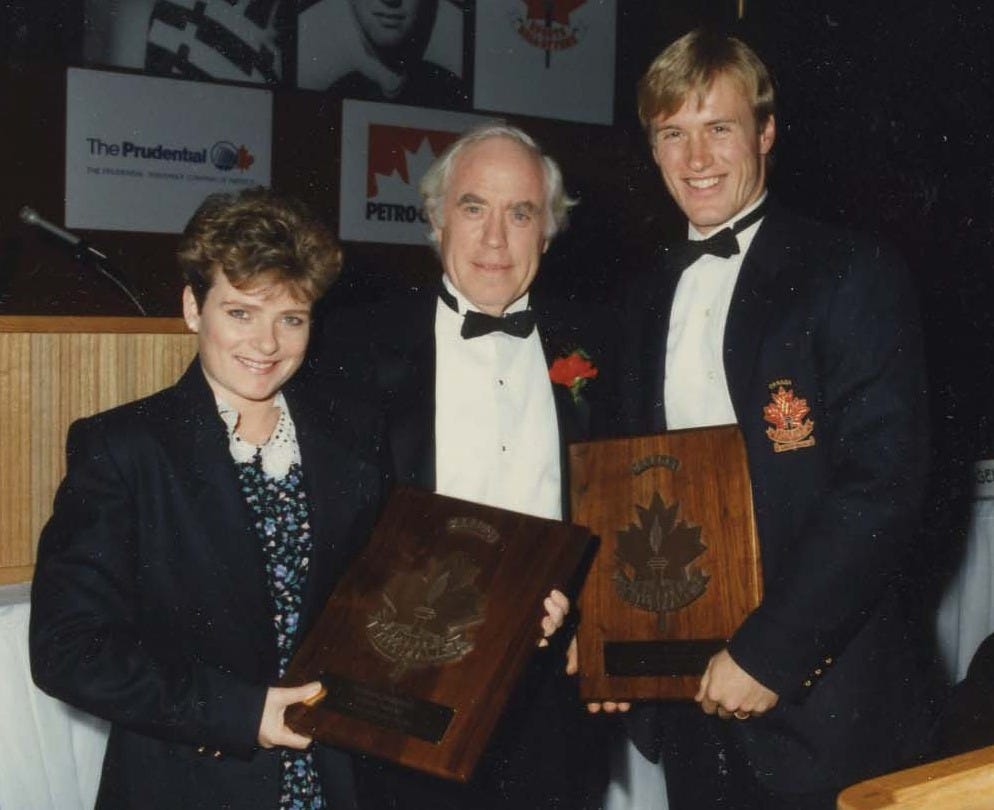From Olympic heartbreak to hometown glory
Barbara Underhill and Paul Martini had an Olympic Games to forget in 1984, and it was shaping up to be an even worse World Championships, held in Canada, only three weeks later.
It is difficult to quantify the chemistry of a team, especially in a sport such as figure skating, where outstanding pairs must combine individual excellence with flawless teamwork. If longevity at the highest levels of success is any measure, Barbara Underhill and Paul Martini were one of Canada's most successful figure skating duos.
Both began skating at age five, but they met at a summer skating school in Weston, Ontario, in 1977, when she was 14 and he 16. They immediately clicked on the ice, and within a year they were Canada's junior pairs figure skating champions headed for the world junior championships in Megève, France. Not only did Barbara and Paul capture the junior world title, they also won events in St. Gervais, France, and Oberstdorf, West Germany, earning a promotion to the senior figure skating scene as a result.
At the 1979 Canadian national figure skating championships in Thunder Bay, they captured the senior pairs championship. It was the first of five consecutive national championships for the pair. They finished ninth in their first Olympic figure skating tournament in 1980 at Lake Placid but showed steady improvement at the world championships, finishing eleventh in 1980, seventh in 1981, and fourth in 1982. With the help of coach Louis Strong and choreographer Sandra Bezic, Barbara and Paul also excelled at other international events, winning at St. Ivel in 1980 and Skate America in 1981, to go along with victories in the 1981 Ennia Cup and at the invitational NHK Trophy in 1980 and 1982.
The breakthrough at the world championships for Barbara and Paul came in 1983 at Helsinki, where a near-flawless performance earned them a bronze medal behind pairs from the Soviet Union and East Germany. It was Canada's first Olympic or world championship medal in pairs figure skating since Debbie Wilkes and Guy Revell had won world championship bronze in 1964. The success brought Barbara and Paul national recognition and raised hopes for the 1984 Winter Olympic Games in Sarajevo.
An ankle injury to Barbara forced the pair to skip the Canadian national championships, but they still headed to Sarajevo as medal favourites. Those hopes were soon dashed as Barbara and Paul skated the short program. During their sit spin, Barbara caught an edge and fell to the ice. It was an error from which the pair could not recover, and they finished the Olympic competition in a disappointing seventh place. Compounding their disappointment was the fact that the world championships were only a month away.
But after finding the will to continue competing and with Barbara wearing a more comfortable older skate boot, the pair took to the ice in Ottawa in front of a crowd that was solidly behind them. Barbara and Paul skated two of the best performances of their careers, the long program bringing 10,000 spectators to their feet. They became the first Canadian pairs figure skating world champions in 22 years by defeating the defending Olympic and world championship pair from the Soviet Union.
Barbara and Paul retired from competitive amateur skating following the 1984 world championships and turned to professional skating with the Ice Capades. Barbara and Paul were the pairs gold medallists at the world professional figure skating championships in 1984, 1986, 1987, 1988, 1989, 1990, and 1993. They also finished second in 1996 and third in 1985 and 1995.
The pair remained in the public eye following their retirement as regular commentators on Canadian telecasts of Olympic, world championship, and other major figure skating events. They also pursued careers in coaching. Barbara has devoted much of her time to working with the child safety foundation established in her daughter's memory. The Stephanie Gaetz Keepsafe Foundation was launched one night in May 1998 when Barbara and Paul performed a farewell show at Toronto's Maple Leaf Gardens.
Barbara Underhill and Paul Martini were awarded the Order of Sport and inducted into Canada’s Sports Hall of Fame in 1988.
On peut difficilement quantifier la chimie au sein d’une équipe, surtout dans le cas d’un sport comme le patinage artistique où les meilleurs couples doivent marier l’excellence individuelle à un travail d’équipe sans faille. Mais si la longévité au sommet de leur art sert d’instrument de mesure, Barbara Underhill et Paul Martini sont l’un des duos les plus prolifiques que le Canada ait connu.
Les deux commencent à patiner à l’âge de cinq ans et font connaissance en 1977 dans le cadre d’une école estivale de patinage à Weston, en Ontario. Barbara et Paul sont alors respectivement âgés de 14 et 16 ans. Dès leurs premiers pas sur la glace, ils se complètent à merveille et moins d’un an plus tard ils remportent ensemble le championnat canadien en couple chez les juniors et une participation aux Championnats du monde à Megève, en France. Non seulement remportent-ils le titre mondial chez les juniors, mais ils gagnent des épreuves à St-Gervais, France, Oberstdorf, Allemagne et, par conséquent, sont promus chez les seniors.
Lors des Championnats canadiens de patinage artistique de 1979 à Thunder Bay, ils enlèvent le titre national en couple chez les seniors. Il s’agit du premier de cinq titres canadiens consécutifs pour Martini et Underhill. En 1980, à leurs premiers Jeux Olympiques, disputés à Lake Placid, ils se classent 9e dans la compétition de patinage artistique en couple. En constante progression lors des Championnats du monde, ils obtiennent une 11e place en 1980, puis sont 7e en 1981 pour se hisser au 4e rang en 1982. À l’aide de l’entraîneur Louis Strong et de la chorégraphe Sandra Bezic, Underhill et Martini excellent lors de nombreuses compétitions internationales, remportant l’or à St-Ivel en 1980 et au Skate America l’année suivante. Ils atteignent aussi la plus haute marche du podium à la Coupe Ennia en 1981 en plus du trophée NHK en 1980 et en 1982.
Pour Underhill et Martini, la percée aux Championnats du monde survient en 1983, à Helsinki, où une performance qui frôle la perfection leur procure une médaille de bronze derrière les couples de l’Union soviétique et de l’Allemagne de l’Est. Il s’agit pour le Canada de la première médaille de patinage artistique en couple, aux Olympiques ou aux Championnats du monde, depuis la médaille de bronze du duo de Debbie Wilkes et Guy Revell aux Championnats du monde en 1964. Cette performance vaut à Underhill et Martini une reconnaissance nationale tout en augmentant les espoirs de médaille pour les Olympiques d’hiver à Sarajevo en 1984.
Une blessure à la cheville pour Underhill oblige le couple à rater les Championnats canadiens, mais le duo se dirige à Sarajevo comme de véritables aspirants au podium. Mais ces espoirs se dissipent rapidement avec la performance de Underhill et Martini dans le programme court. Lors de l’une des approches de saut, Underhill perd pied – qui n’est aucunement une conséquence à la récente blessure à la cheville comme elle le confirmera par la suite – et chute. Le couple ne pourra surmonter le déficit et se contentera d’une décevante 7e place. Leur déception est d’autant plus grande qu’ils ne sont qu’à un mois des Championnats du monde.
Retrouvant leur désir de continuer à concourir, et Underhill qui retourne à un patin plus confortable, le couple se présente aux Championnats du monde à Ottawa où la foule leur réserve un appui sans équivoque. Underhill et Martini réussissent deux de leurs plus solides performances en carrière dont leur programme long qui fait littéralement bondir les 10 000 spectateurs de leurs sièges. Ils deviennent le premier couple canadien en 22 ans à remporter le Championnat du monde en surpassant le duo de l’Union soviétique qui est champion olympique et du monde en titre.
À la suite des Championnats du monde en 1984, Underhill et Martini se retirent de la compétition active pour amorcer une carrière chez les professionnels en se joignant aux Ice Capades. Le couple remportera la médaille d’or des Championnats du monde professionnels de patinage artistique en 1984, 1986-1990 et 1993.
Barbara et Paul demeurent dans le monde du patinage artistique à titre d’analystes à la télévision canadienne lors des compétitions olympiques, des Championnats du monde et de plusieurs autres événements majeurs sur la scène du patinage artistique. Paul Martini s’est également tourné vers une carrière d’entraîneur alors que Barbara Underhill consacre temps et énergies à la fondation pour la sécurité des enfants instaurée à la mémoire de sa fille. La Fondation Stephanie-Gaetz Keepsafe a été lancée en mai 1998 à l’occasion d’un spectacle d’adieu au Maple Leaf Gardens à Toronto.






